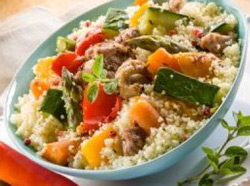 Young U.S. adults and households with children are
key drivers of in-home-prepared ethnic foods, according to new research from Mintel.
Young U.S. adults and households with children are
key drivers of in-home-prepared ethnic foods, according to new research from Mintel.
About nine in 10 Americans 25
to 34 years old report having prepared ethnic foods at home in the past month, versus 68% of those 65 and older, Mintel reports.
In addition, 91% of Americans with children
under the age of 18 report having cooked ethnic food at home in the past month, compared with 78% of those without children.
As the palates of Americans, and younger people in
particular, become more adventurous and sophisticated, “they are eager to explore lesser-known cuisines with unique flavor combinations,” notes John N. Frank, category manager, CPG food
& drink at Mintel.
advertisement
advertisement
While households with children over-index on consumption of all types of ethnic food prepared at home, Hispanic food is the most popular, with 72% of
respondents from households with children reporting having prepared this cuisine at home in the past month, compared to only 50% of those without children.
Hispanic food is also the most
popular with all home cooks: 58% report having prepared such fare within the last month, versus 55% and 44% having prepared Italian or Asian fare, respectively.
The at-home
ethnic foods category actually showed particularly strong performance during the recession, showing overall sales growth of 12% between 2007 and 2009 – likely driven by consumers’ cutting
back on restaurant meals in favor of more at-home dining, Mintel reports.
Category growth has slowed quite a bit in the last three years: Sales grew 4.5% between 2010 and 2012
(reaching total estimated U.S. sales of $8.7 billion in 2012). Again, this likely reflects restaurant trends – in this case, a return to more out-of-home dining as the economy has continued its
recovery.
“When it comes to ethnic food eaten and prepared at home, restaurants continue to pose a threat because of constant innovation that attracts consumers,”
observes Mintel food analyst Carla Dobre-Chastain. “To remain competitive, companies need to focus on product development that blends authenticity with familiarity, while offering unique flavor
combinations. In addition, providing consumers with the ability to customize their dish and emphasizing functional benefits could prove to be lucrative strategies.”
However,
restaurant trends may have helped the category in at least one respect. “The popularity of Hispanic food is likely due to how mainstream it has become in the U.S. and the ease and convenience of
preparing it,” says Frank, but in addition, “the endless supply of Mexican, Cuban and other Hispanic-based restaurants have given home cooks infinite possibilities for re-creating these
restaurant-style meals at home.”
Moreover, Mintel forecasts that high growth rates for the prepared-at-home ethnic food market will resume, growing by 20.3% between 2012 and
2017.
Factors expected to contribute to that growth include continued consumer interest; expected food-price increases for 2013 (likely making relatively inexpensive at-home
options, like ethnic foods, more attractive again); and more focused product development.
Mintel stresses that much depends on product innovation that meets consumer needs. That
balance of authenticity and familiarity noted by Dobre-Chastain comes into play in developing a range of products that appeal both to fast-growing multicultural groups and the growing number of
consumers interested in exploring new cuisines and unique and traditional flavors.